SITHKOP004: Developing Menus for Special Dietary Requirements
VerifiedAdded on 2024/05/15
|23
|4483
|431
Homework Assignment
AI Summary
This assignment explores the development of menus catering to special dietary requirements, aligning with the Australian Guide to Healthy Eating. It addresses the implications for chefs in creating nutritious meals, particularly for individuals with conditions like Coeliac disease, diabetes, and lactose intolerance. The assignment details considerations for selecting, preparing, and serving food to patients with specific needs, emphasizing gluten-free options and managing potential allergic reactions. Furthermore, it covers religious dietary requirements, such as those for Jewish, Muslim, and Hindu customers, and discusses the importance of texture modification for patients with swallowing difficulties. The role of equipment in preparing texture-modified foods is highlighted, along with potential reactions to food allergies and the legal consequences of negligence in addressing special dietary needs. Desklib offers a variety of resources, including past papers and solved assignments, to aid students in their studies.
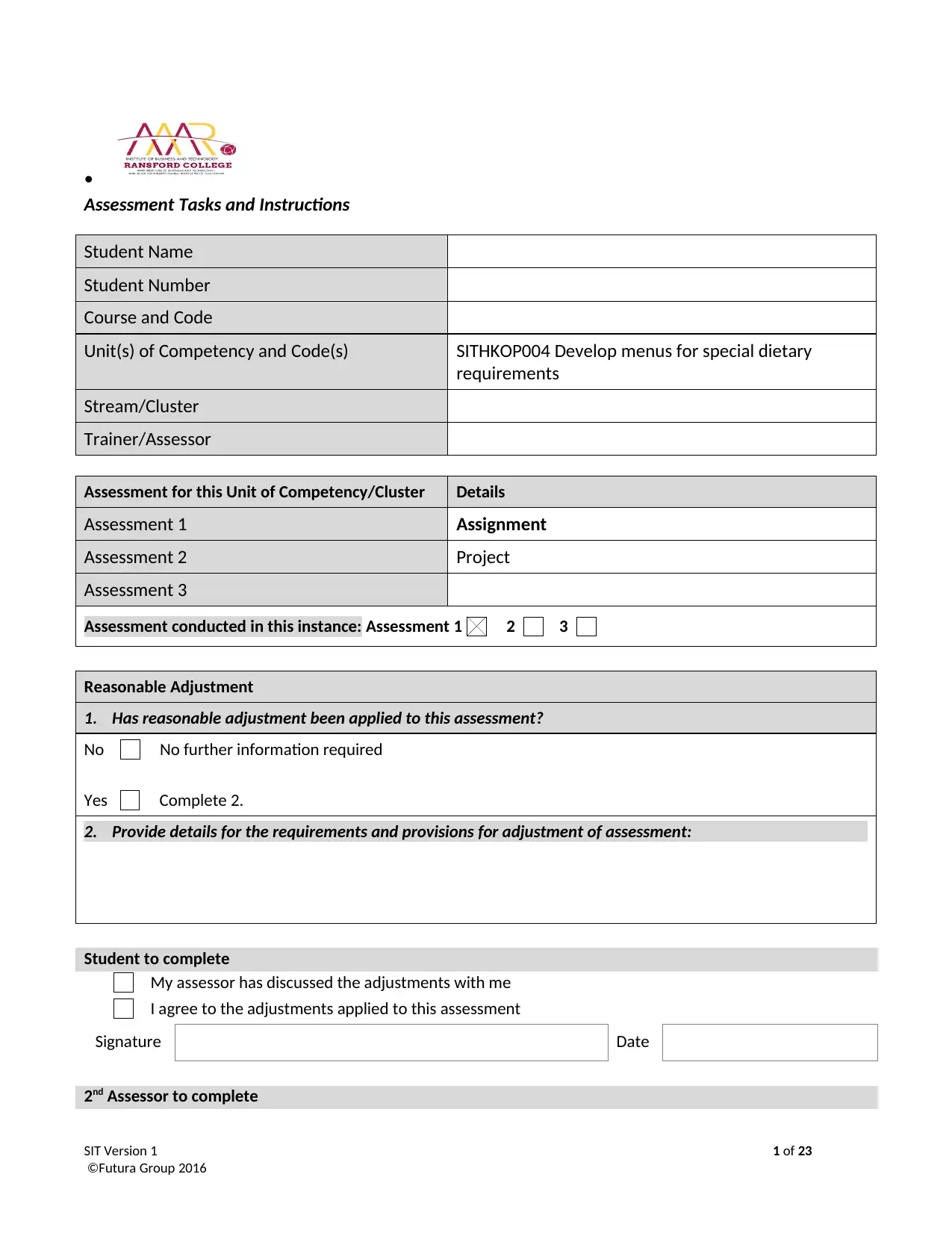
•
Assessment Tasks and Instructions
Student Name
Student Number
Course and Code
Unit(s) of Competency and Code(s) SITHKOP004 Develop menus for special dietary
requirements
Stream/Cluster
Trainer/Assessor
Assessment for this Unit of Competency/Cluster Details
Assessment 1 Assignment
Assessment 2 Project
Assessment 3
Assessment conducted in this instance: Assessment 1 2 3
Reasonable Adjustment
1. Has reasonable adjustment been applied to this assessment?
No No further information required
Yes Complete 2.
2. Provide details for the requirements and provisions for adjustment of assessment:
Student to complete
My assessor has discussed the adjustments with me
I agree to the adjustments applied to this assessment
Signature Date
2nd Assessor to complete
SIT Version 1 1 of 23
©Futura Group 2016
Assessment Tasks and Instructions
Student Name
Student Number
Course and Code
Unit(s) of Competency and Code(s) SITHKOP004 Develop menus for special dietary
requirements
Stream/Cluster
Trainer/Assessor
Assessment for this Unit of Competency/Cluster Details
Assessment 1 Assignment
Assessment 2 Project
Assessment 3
Assessment conducted in this instance: Assessment 1 2 3
Reasonable Adjustment
1. Has reasonable adjustment been applied to this assessment?
No No further information required
Yes Complete 2.
2. Provide details for the requirements and provisions for adjustment of assessment:
Student to complete
My assessor has discussed the adjustments with me
I agree to the adjustments applied to this assessment
Signature Date
2nd Assessor to complete
SIT Version 1 1 of 23
©Futura Group 2016
Paraphrase This Document
Need a fresh take? Get an instant paraphrase of this document with our AI Paraphraser
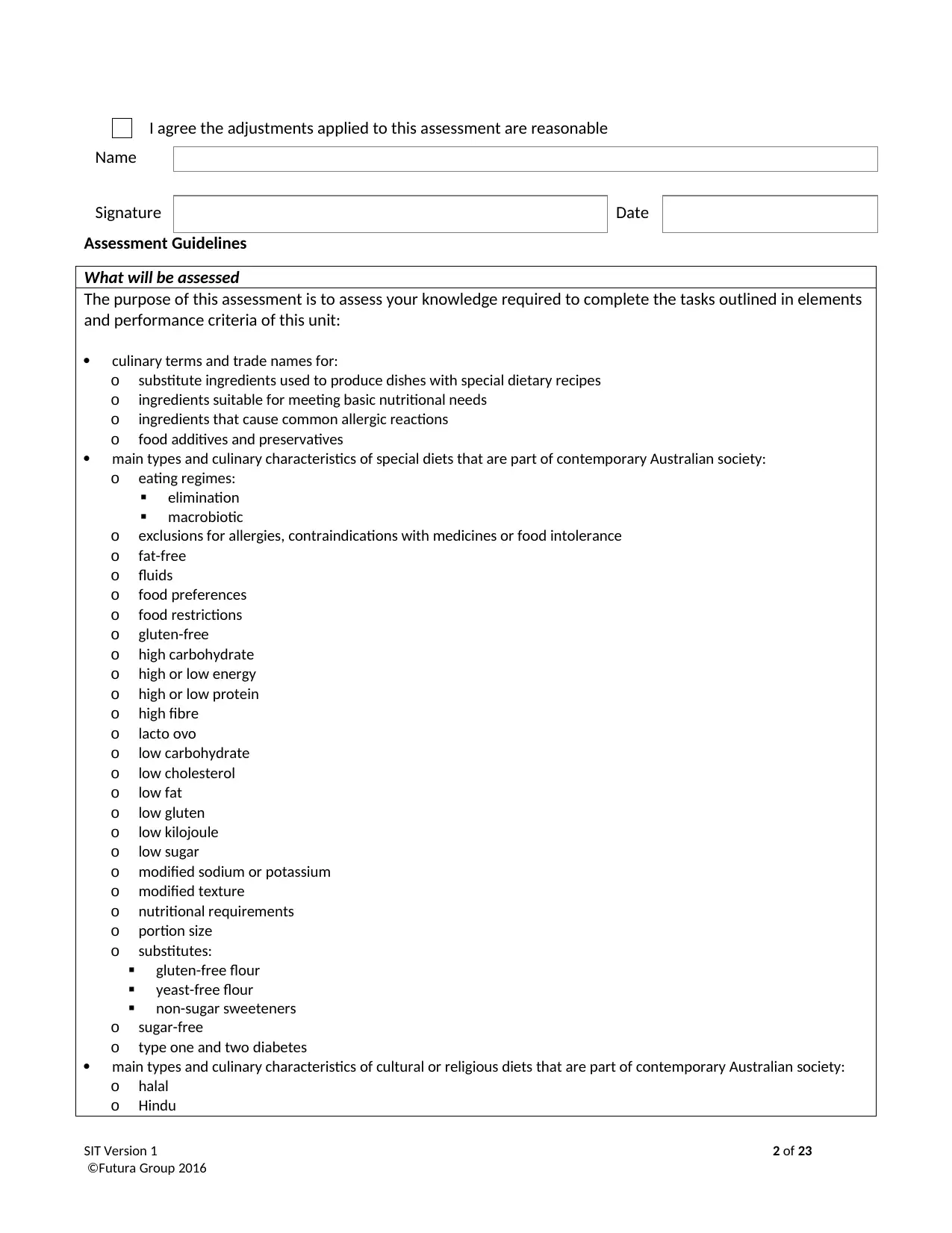
I agree the adjustments applied to this assessment are reasonable
Name
Signature Date
Assessment Guidelines
What will be assessed
The purpose of this assessment is to assess your knowledge required to complete the tasks outlined in elements
and performance criteria of this unit:
culinary terms and trade names for:
o substitute ingredients used to produce dishes with special dietary recipes
o ingredients suitable for meeting basic nutritional needs
o ingredients that cause common allergic reactions
o food additives and preservatives
main types and culinary characteristics of special diets that are part of contemporary Australian society:
o eating regimes:
elimination
macrobiotic
o exclusions for allergies, contraindications with medicines or food intolerance
o fat-free
o fluids
o food preferences
o food restrictions
o gluten-free
o high carbohydrate
o high or low energy
o high or low protein
o high fibre
o lacto ovo
o low carbohydrate
o low cholesterol
o low fat
o low gluten
o low kilojoule
o low sugar
o modified sodium or potassium
o modified texture
o nutritional requirements
o portion size
o substitutes:
gluten-free flour
yeast-free flour
non-sugar sweeteners
o sugar-free
o type one and two diabetes
main types and culinary characteristics of cultural or religious diets that are part of contemporary Australian society:
o halal
o Hindu
SIT Version 1 2 of 23
©Futura Group 2016
Name
Signature Date
Assessment Guidelines
What will be assessed
The purpose of this assessment is to assess your knowledge required to complete the tasks outlined in elements
and performance criteria of this unit:
culinary terms and trade names for:
o substitute ingredients used to produce dishes with special dietary recipes
o ingredients suitable for meeting basic nutritional needs
o ingredients that cause common allergic reactions
o food additives and preservatives
main types and culinary characteristics of special diets that are part of contemporary Australian society:
o eating regimes:
elimination
macrobiotic
o exclusions for allergies, contraindications with medicines or food intolerance
o fat-free
o fluids
o food preferences
o food restrictions
o gluten-free
o high carbohydrate
o high or low energy
o high or low protein
o high fibre
o lacto ovo
o low carbohydrate
o low cholesterol
o low fat
o low gluten
o low kilojoule
o low sugar
o modified sodium or potassium
o modified texture
o nutritional requirements
o portion size
o substitutes:
gluten-free flour
yeast-free flour
non-sugar sweeteners
o sugar-free
o type one and two diabetes
main types and culinary characteristics of cultural or religious diets that are part of contemporary Australian society:
o halal
o Hindu
SIT Version 1 2 of 23
©Futura Group 2016
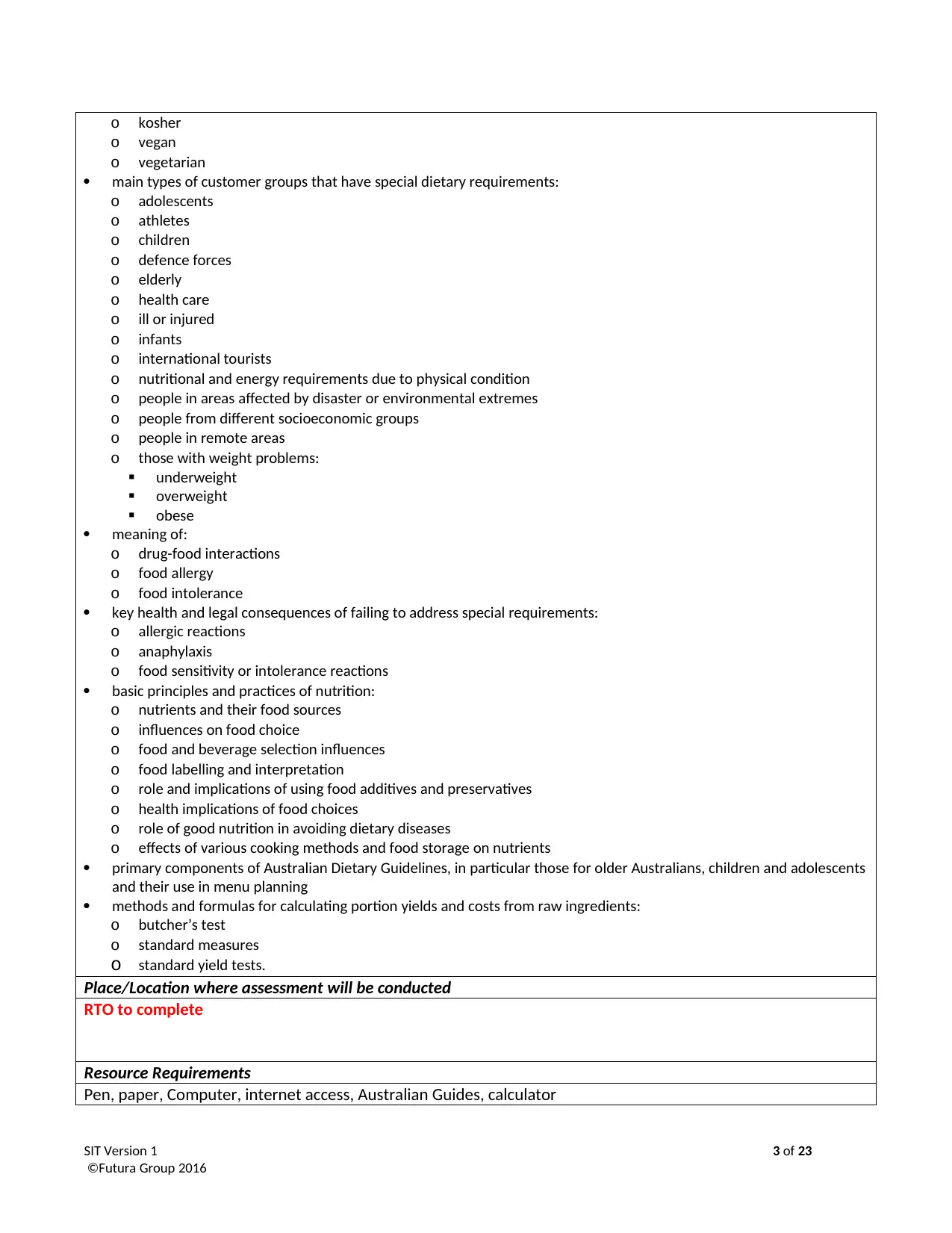
o kosher
o vegan
o vegetarian
main types of customer groups that have special dietary requirements:
o adolescents
o athletes
o children
o defence forces
o elderly
o health care
o ill or injured
o infants
o international tourists
o nutritional and energy requirements due to physical condition
o people in areas affected by disaster or environmental extremes
o people from different socioeconomic groups
o people in remote areas
o those with weight problems:
underweight
overweight
obese
meaning of:
o drug-food interactions
o food allergy
o food intolerance
key health and legal consequences of failing to address special requirements:
o allergic reactions
o anaphylaxis
o food sensitivity or intolerance reactions
basic principles and practices of nutrition:
o nutrients and their food sources
o influences on food choice
o food and beverage selection influences
o food labelling and interpretation
o role and implications of using food additives and preservatives
o health implications of food choices
o role of good nutrition in avoiding dietary diseases
o effects of various cooking methods and food storage on nutrients
primary components of Australian Dietary Guidelines, in particular those for older Australians, children and adolescents
and their use in menu planning
methods and formulas for calculating portion yields and costs from raw ingredients:
o butcher’s test
o standard measures
o standard yield tests.
Place/Location where assessment will be conducted
RTO to complete
Resource Requirements
Pen, paper, Computer, internet access, Australian Guides, calculator
SIT Version 1 3 of 23
©Futura Group 2016
o vegan
o vegetarian
main types of customer groups that have special dietary requirements:
o adolescents
o athletes
o children
o defence forces
o elderly
o health care
o ill or injured
o infants
o international tourists
o nutritional and energy requirements due to physical condition
o people in areas affected by disaster or environmental extremes
o people from different socioeconomic groups
o people in remote areas
o those with weight problems:
underweight
overweight
obese
meaning of:
o drug-food interactions
o food allergy
o food intolerance
key health and legal consequences of failing to address special requirements:
o allergic reactions
o anaphylaxis
o food sensitivity or intolerance reactions
basic principles and practices of nutrition:
o nutrients and their food sources
o influences on food choice
o food and beverage selection influences
o food labelling and interpretation
o role and implications of using food additives and preservatives
o health implications of food choices
o role of good nutrition in avoiding dietary diseases
o effects of various cooking methods and food storage on nutrients
primary components of Australian Dietary Guidelines, in particular those for older Australians, children and adolescents
and their use in menu planning
methods and formulas for calculating portion yields and costs from raw ingredients:
o butcher’s test
o standard measures
o standard yield tests.
Place/Location where assessment will be conducted
RTO to complete
Resource Requirements
Pen, paper, Computer, internet access, Australian Guides, calculator
SIT Version 1 3 of 23
©Futura Group 2016
⊘ This is a preview!⊘
Do you want full access?
Subscribe today to unlock all pages.

Trusted by 1+ million students worldwide
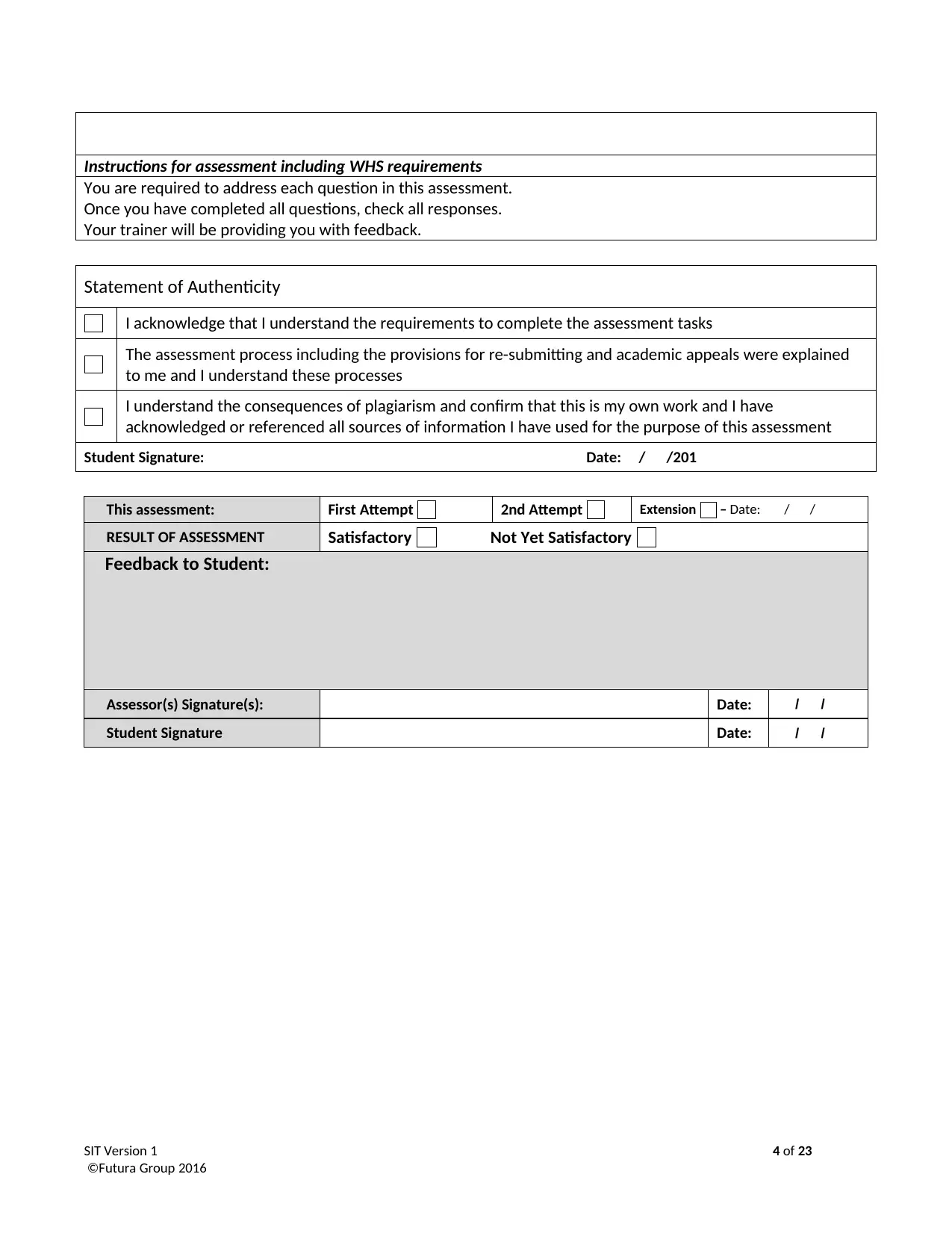
Instructions for assessment including WHS requirements
You are required to address each question in this assessment.
Once you have completed all questions, check all responses.
Your trainer will be providing you with feedback.
Statement of Authenticity
I acknowledge that I understand the requirements to complete the assessment tasks
The assessment process including the provisions for re-submitting and academic appeals were explained
to me and I understand these processes
I understand the consequences of plagiarism and confirm that this is my own work and I have
acknowledged or referenced all sources of information I have used for the purpose of this assessment
Student Signature: Date: / /201
This assessment: First Attempt 2nd Attempt Extension – Date: / /
RESULT OF ASSESSMENT Satisfactory Not Yet Satisfactory
Feedback to Student:
Assessor(s) Signature(s): Date: / /
Student Signature Date: / /
SIT Version 1 4 of 23
©Futura Group 2016
You are required to address each question in this assessment.
Once you have completed all questions, check all responses.
Your trainer will be providing you with feedback.
Statement of Authenticity
I acknowledge that I understand the requirements to complete the assessment tasks
The assessment process including the provisions for re-submitting and academic appeals were explained
to me and I understand these processes
I understand the consequences of plagiarism and confirm that this is my own work and I have
acknowledged or referenced all sources of information I have used for the purpose of this assessment
Student Signature: Date: / /201
This assessment: First Attempt 2nd Attempt Extension – Date: / /
RESULT OF ASSESSMENT Satisfactory Not Yet Satisfactory
Feedback to Student:
Assessor(s) Signature(s): Date: / /
Student Signature Date: / /
SIT Version 1 4 of 23
©Futura Group 2016
Paraphrase This Document
Need a fresh take? Get an instant paraphrase of this document with our AI Paraphraser
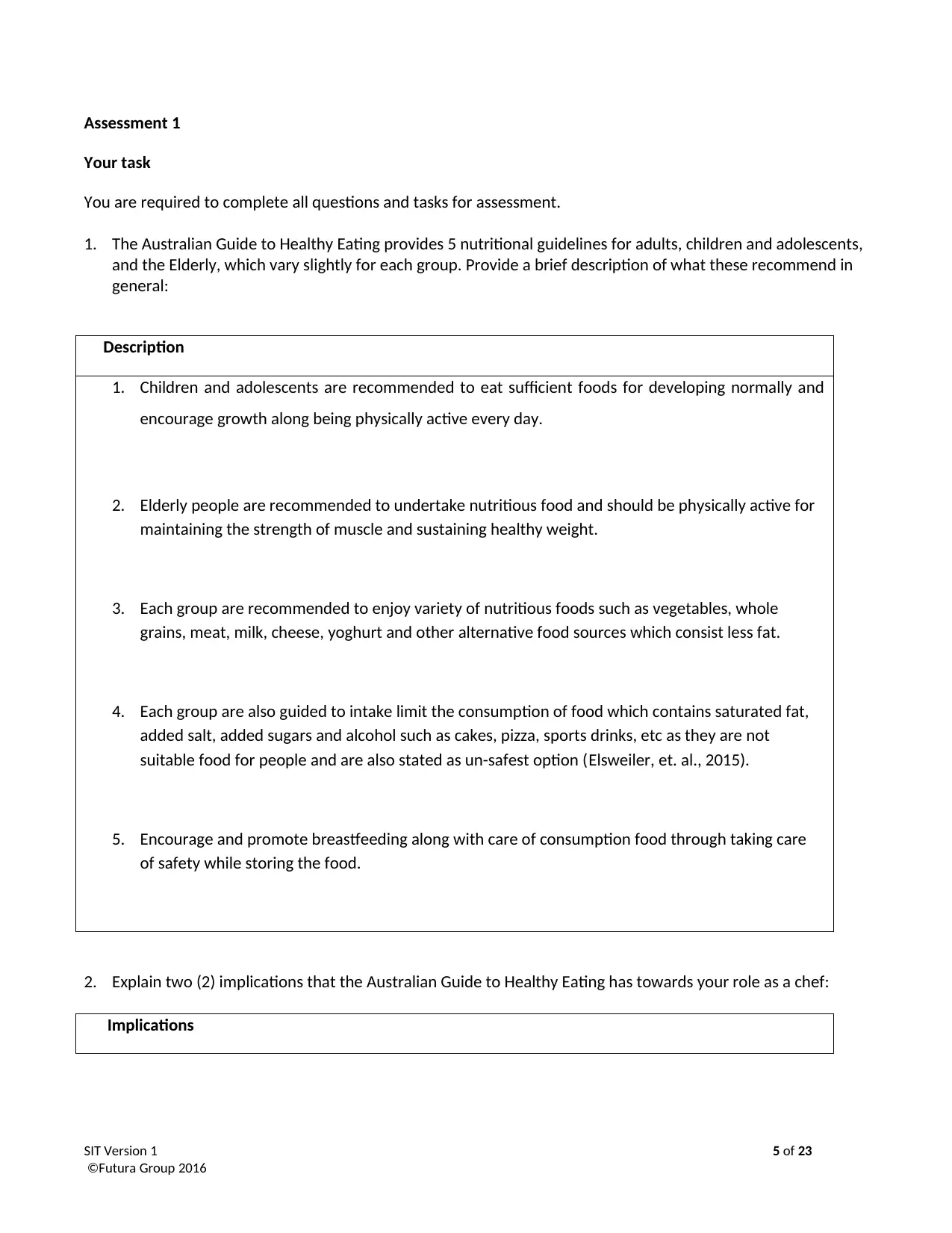
Assessment 1
Your task
You are required to complete all questions and tasks for assessment.
1. The Australian Guide to Healthy Eating provides 5 nutritional guidelines for adults, children and adolescents,
and the Elderly, which vary slightly for each group. Provide a brief description of what these recommend in
general:
Description
1. Children and adolescents are recommended to eat sufficient foods for developing normally and
encourage growth along being physically active every day.
2. Elderly people are recommended to undertake nutritious food and should be physically active for
maintaining the strength of muscle and sustaining healthy weight.
3. Each group are recommended to enjoy variety of nutritious foods such as vegetables, whole
grains, meat, milk, cheese, yoghurt and other alternative food sources which consist less fat.
4. Each group are also guided to intake limit the consumption of food which contains saturated fat,
added salt, added sugars and alcohol such as cakes, pizza, sports drinks, etc as they are not
suitable food for people and are also stated as un-safest option (Elsweiler, et. al., 2015).
5. Encourage and promote breastfeeding along with care of consumption food through taking care
of safety while storing the food.
2. Explain two (2) implications that the Australian Guide to Healthy Eating has towards your role as a chef:
Implications
SIT Version 1 5 of 23
©Futura Group 2016
Your task
You are required to complete all questions and tasks for assessment.
1. The Australian Guide to Healthy Eating provides 5 nutritional guidelines for adults, children and adolescents,
and the Elderly, which vary slightly for each group. Provide a brief description of what these recommend in
general:
Description
1. Children and adolescents are recommended to eat sufficient foods for developing normally and
encourage growth along being physically active every day.
2. Elderly people are recommended to undertake nutritious food and should be physically active for
maintaining the strength of muscle and sustaining healthy weight.
3. Each group are recommended to enjoy variety of nutritious foods such as vegetables, whole
grains, meat, milk, cheese, yoghurt and other alternative food sources which consist less fat.
4. Each group are also guided to intake limit the consumption of food which contains saturated fat,
added salt, added sugars and alcohol such as cakes, pizza, sports drinks, etc as they are not
suitable food for people and are also stated as un-safest option (Elsweiler, et. al., 2015).
5. Encourage and promote breastfeeding along with care of consumption food through taking care
of safety while storing the food.
2. Explain two (2) implications that the Australian Guide to Healthy Eating has towards your role as a chef:
Implications
SIT Version 1 5 of 23
©Futura Group 2016
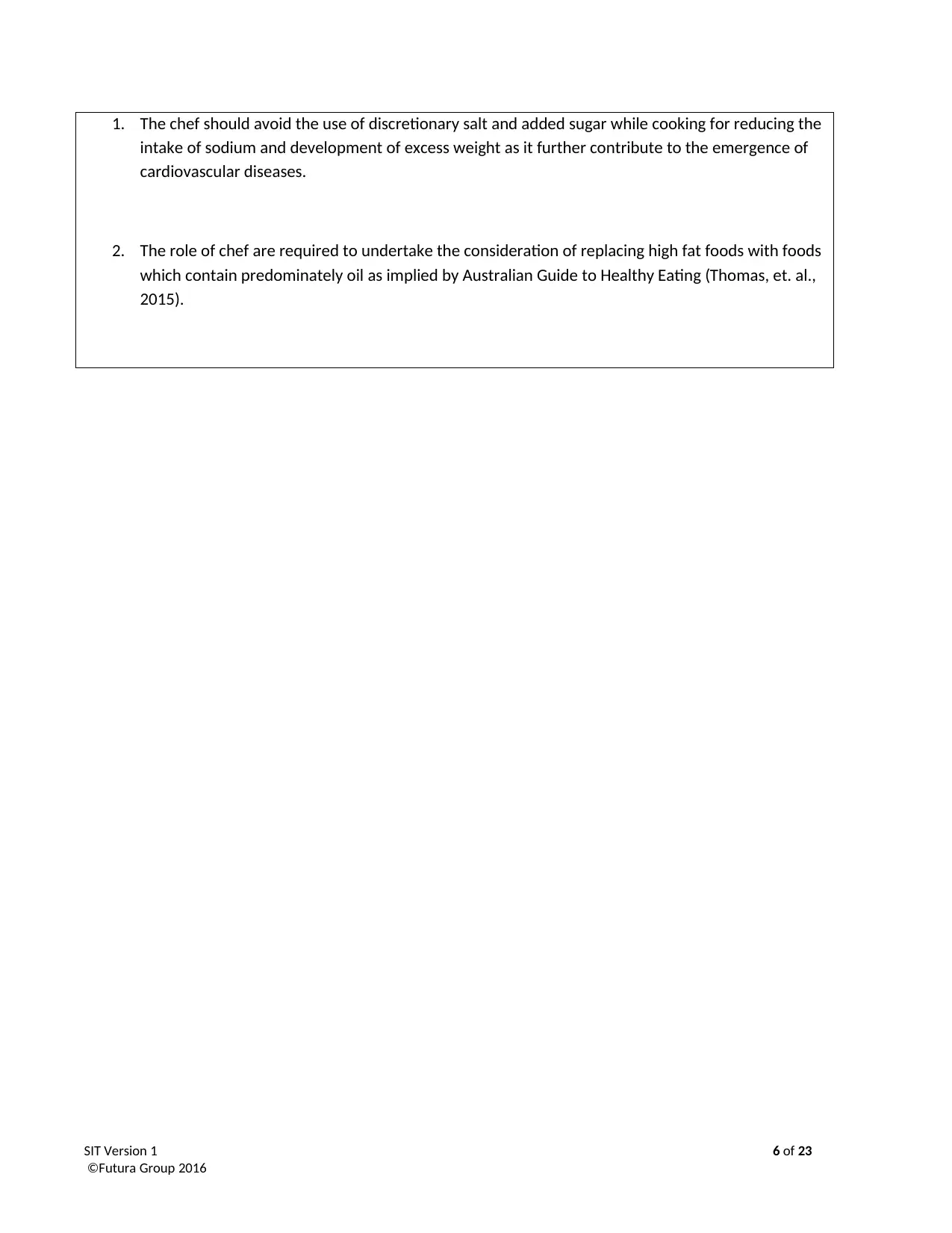
1. The chef should avoid the use of discretionary salt and added sugar while cooking for reducing the
intake of sodium and development of excess weight as it further contribute to the emergence of
cardiovascular diseases.
2. The role of chef are required to undertake the consideration of replacing high fat foods with foods
which contain predominately oil as implied by Australian Guide to Healthy Eating (Thomas, et. al.,
2015).
SIT Version 1 6 of 23
©Futura Group 2016
intake of sodium and development of excess weight as it further contribute to the emergence of
cardiovascular diseases.
2. The role of chef are required to undertake the consideration of replacing high fat foods with foods
which contain predominately oil as implied by Australian Guide to Healthy Eating (Thomas, et. al.,
2015).
SIT Version 1 6 of 23
©Futura Group 2016
⊘ This is a preview!⊘
Do you want full access?
Subscribe today to unlock all pages.

Trusted by 1+ million students worldwide
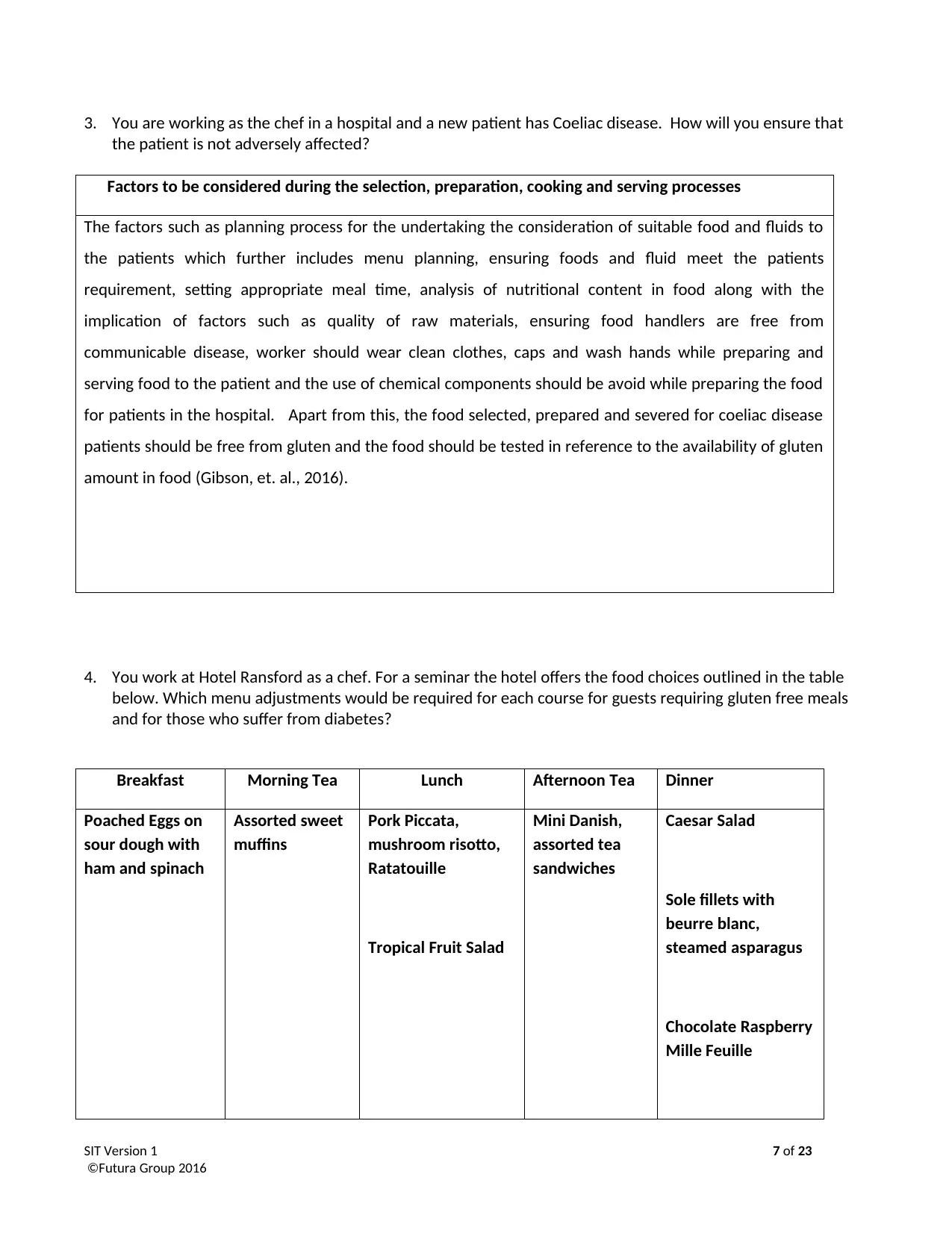
3. You are working as the chef in a hospital and a new patient has Coeliac disease. How will you ensure that
the patient is not adversely affected?
Factors to be considered during the selection, preparation, cooking and serving processes
The factors such as planning process for the undertaking the consideration of suitable food and fluids to
the patients which further includes menu planning, ensuring foods and fluid meet the patients
requirement, setting appropriate meal time, analysis of nutritional content in food along with the
implication of factors such as quality of raw materials, ensuring food handlers are free from
communicable disease, worker should wear clean clothes, caps and wash hands while preparing and
serving food to the patient and the use of chemical components should be avoid while preparing the food
for patients in the hospital. Apart from this, the food selected, prepared and severed for coeliac disease
patients should be free from gluten and the food should be tested in reference to the availability of gluten
amount in food (Gibson, et. al., 2016).
4. You work at Hotel Ransford as a chef. For a seminar the hotel offers the food choices outlined in the table
below. Which menu adjustments would be required for each course for guests requiring gluten free meals
and for those who suffer from diabetes?
Breakfast Morning Tea Lunch Afternoon Tea Dinner
Poached Eggs on
sour dough with
ham and spinach
Assorted sweet
muffins
Pork Piccata,
mushroom risotto,
Ratatouille
Tropical Fruit Salad
Mini Danish,
assorted tea
sandwiches
Caesar Salad
Sole fillets with
beurre blanc,
steamed asparagus
Chocolate Raspberry
Mille Feuille
SIT Version 1 7 of 23
©Futura Group 2016
the patient is not adversely affected?
Factors to be considered during the selection, preparation, cooking and serving processes
The factors such as planning process for the undertaking the consideration of suitable food and fluids to
the patients which further includes menu planning, ensuring foods and fluid meet the patients
requirement, setting appropriate meal time, analysis of nutritional content in food along with the
implication of factors such as quality of raw materials, ensuring food handlers are free from
communicable disease, worker should wear clean clothes, caps and wash hands while preparing and
serving food to the patient and the use of chemical components should be avoid while preparing the food
for patients in the hospital. Apart from this, the food selected, prepared and severed for coeliac disease
patients should be free from gluten and the food should be tested in reference to the availability of gluten
amount in food (Gibson, et. al., 2016).
4. You work at Hotel Ransford as a chef. For a seminar the hotel offers the food choices outlined in the table
below. Which menu adjustments would be required for each course for guests requiring gluten free meals
and for those who suffer from diabetes?
Breakfast Morning Tea Lunch Afternoon Tea Dinner
Poached Eggs on
sour dough with
ham and spinach
Assorted sweet
muffins
Pork Piccata,
mushroom risotto,
Ratatouille
Tropical Fruit Salad
Mini Danish,
assorted tea
sandwiches
Caesar Salad
Sole fillets with
beurre blanc,
steamed asparagus
Chocolate Raspberry
Mille Feuille
SIT Version 1 7 of 23
©Futura Group 2016
Paraphrase This Document
Need a fresh take? Get an instant paraphrase of this document with our AI Paraphraser
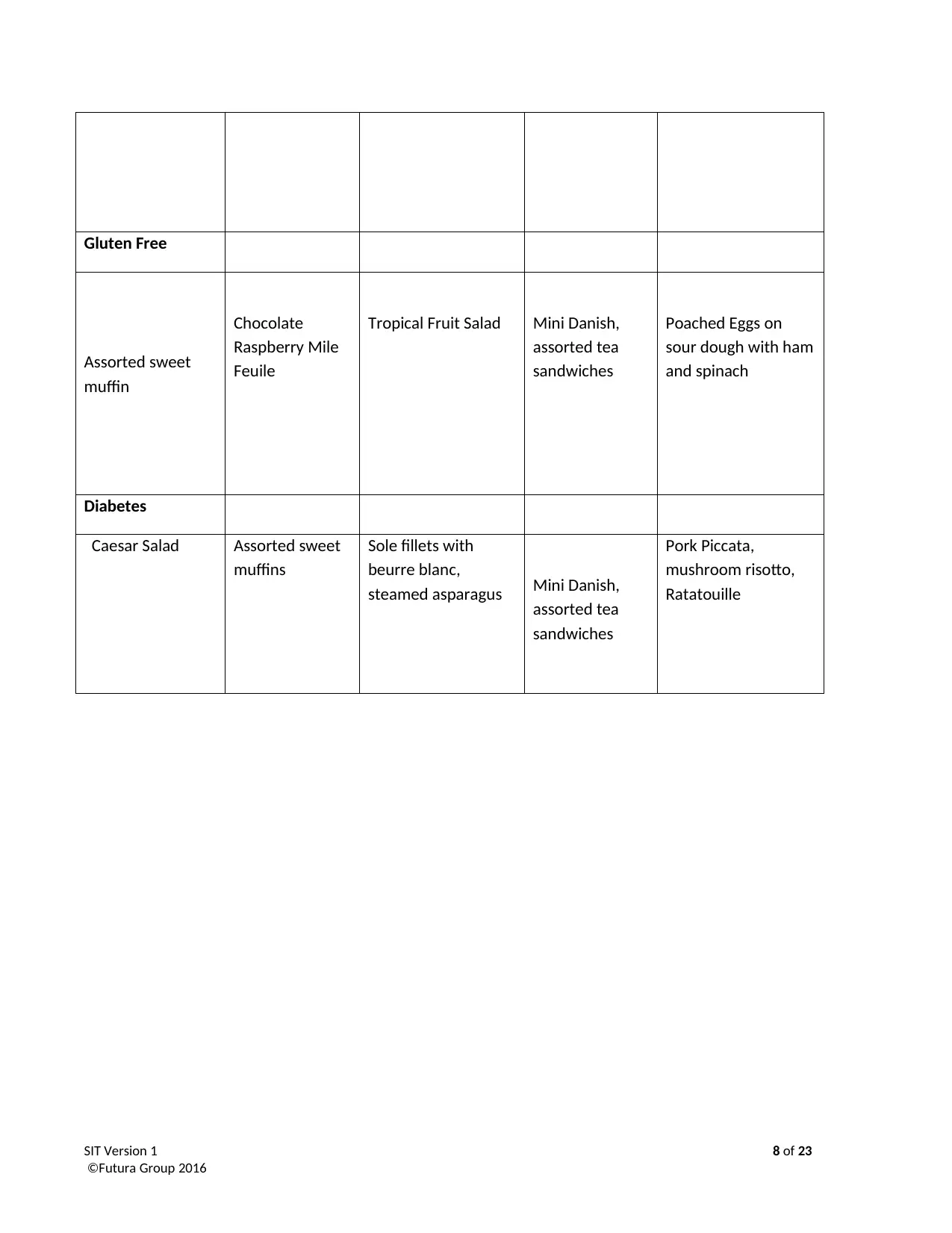
Gluten Free
Assorted sweet
muffin
Chocolate
Raspberry Mile
Feuile
Tropical Fruit Salad Mini Danish,
assorted tea
sandwiches
Poached Eggs on
sour dough with ham
and spinach
Diabetes
Caesar Salad Assorted sweet
muffins
Sole fillets with
beurre blanc,
steamed asparagus Mini Danish,
assorted tea
sandwiches
Pork Piccata,
mushroom risotto,
Ratatouille
SIT Version 1 8 of 23
©Futura Group 2016
Assorted sweet
muffin
Chocolate
Raspberry Mile
Feuile
Tropical Fruit Salad Mini Danish,
assorted tea
sandwiches
Poached Eggs on
sour dough with ham
and spinach
Diabetes
Caesar Salad Assorted sweet
muffins
Sole fillets with
beurre blanc,
steamed asparagus Mini Danish,
assorted tea
sandwiches
Pork Piccata,
mushroom risotto,
Ratatouille
SIT Version 1 8 of 23
©Futura Group 2016
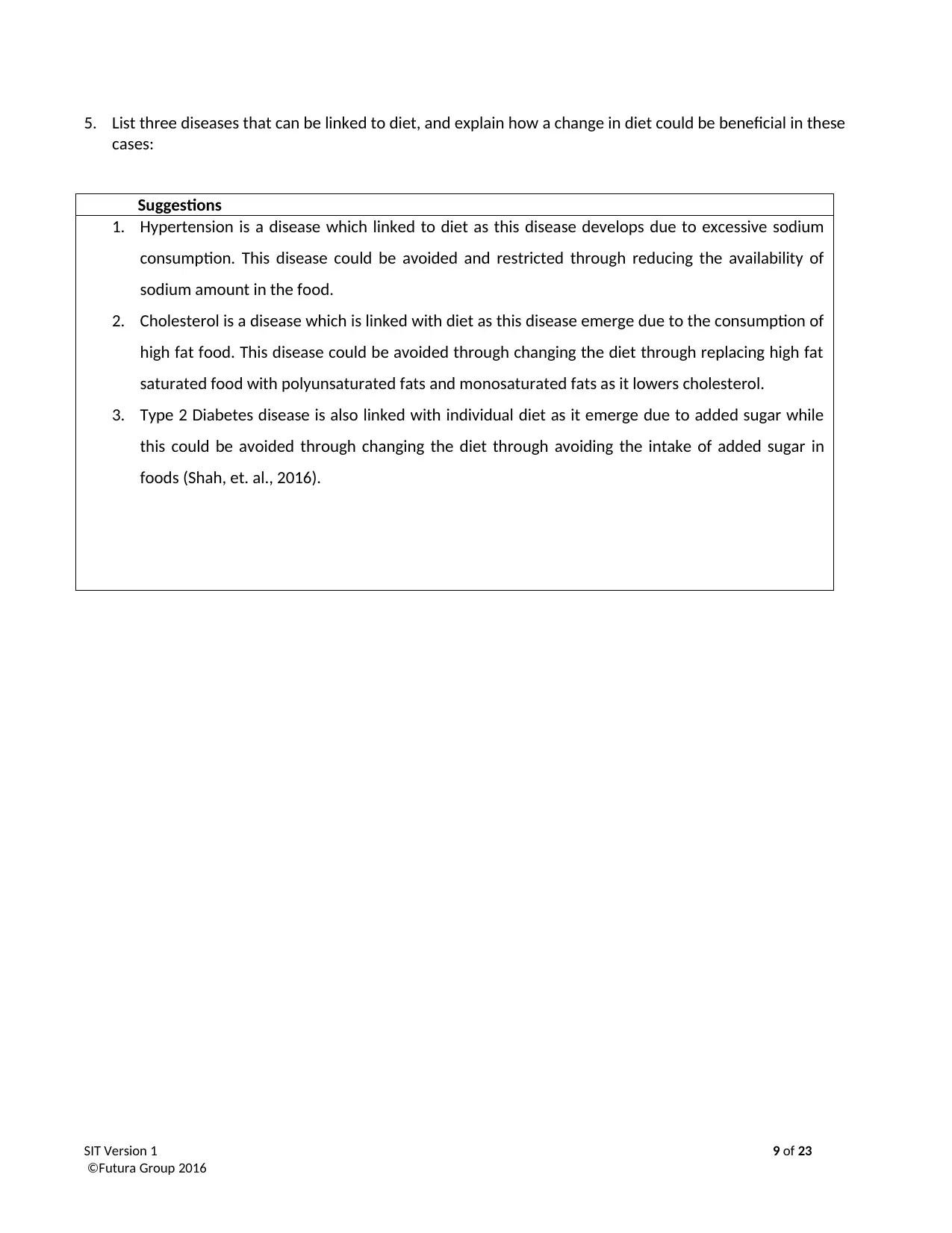
5. List three diseases that can be linked to diet, and explain how a change in diet could be beneficial in these
cases:
Suggestions
1. Hypertension is a disease which linked to diet as this disease develops due to excessive sodium
consumption. This disease could be avoided and restricted through reducing the availability of
sodium amount in the food.
2. Cholesterol is a disease which is linked with diet as this disease emerge due to the consumption of
high fat food. This disease could be avoided through changing the diet through replacing high fat
saturated food with polyunsaturated fats and monosaturated fats as it lowers cholesterol.
3. Type 2 Diabetes disease is also linked with individual diet as it emerge due to added sugar while
this could be avoided through changing the diet through avoiding the intake of added sugar in
foods (Shah, et. al., 2016).
SIT Version 1 9 of 23
©Futura Group 2016
cases:
Suggestions
1. Hypertension is a disease which linked to diet as this disease develops due to excessive sodium
consumption. This disease could be avoided and restricted through reducing the availability of
sodium amount in the food.
2. Cholesterol is a disease which is linked with diet as this disease emerge due to the consumption of
high fat food. This disease could be avoided through changing the diet through replacing high fat
saturated food with polyunsaturated fats and monosaturated fats as it lowers cholesterol.
3. Type 2 Diabetes disease is also linked with individual diet as it emerge due to added sugar while
this could be avoided through changing the diet through avoiding the intake of added sugar in
foods (Shah, et. al., 2016).
SIT Version 1 9 of 23
©Futura Group 2016
⊘ This is a preview!⊘
Do you want full access?
Subscribe today to unlock all pages.

Trusted by 1+ million students worldwide
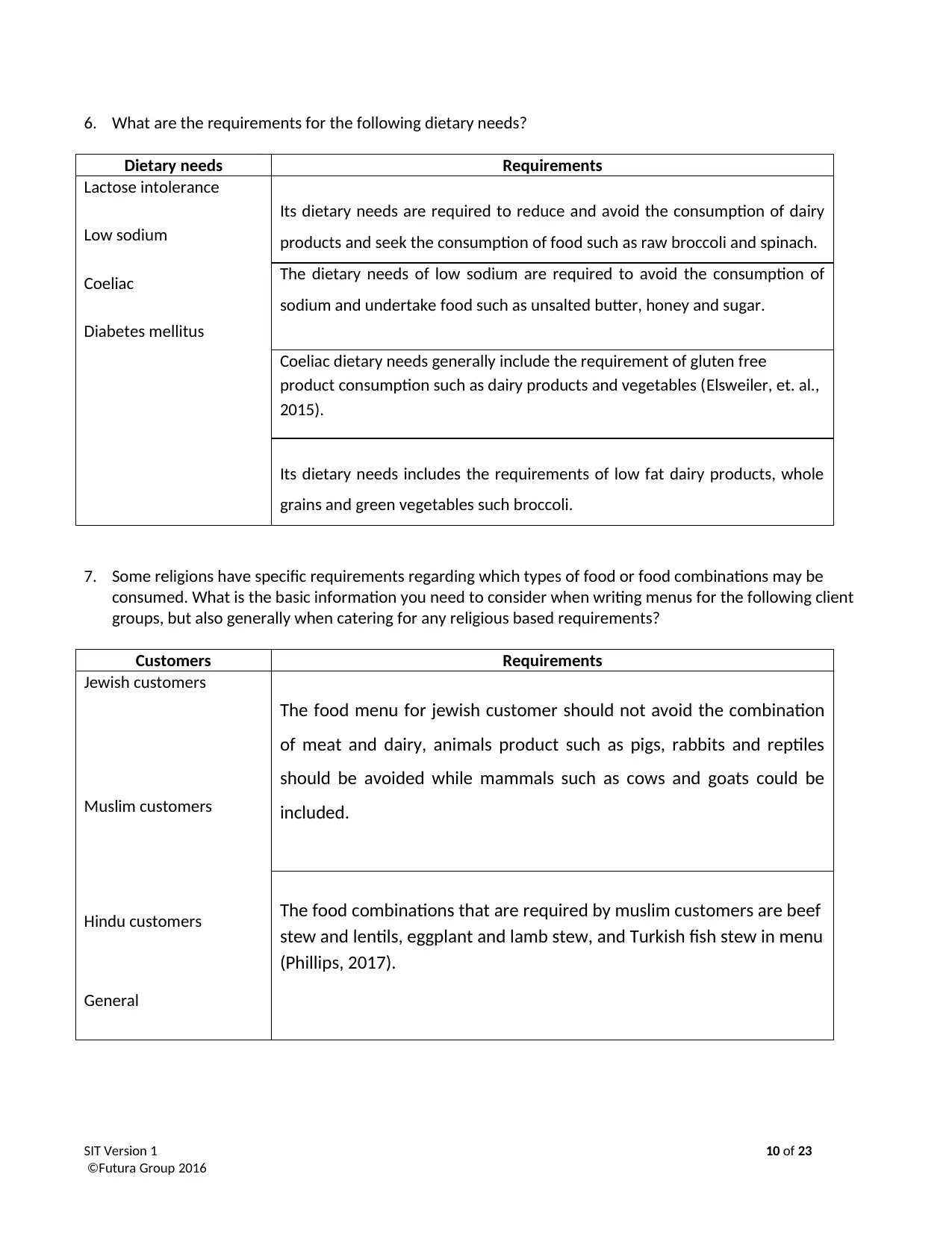
6. What are the requirements for the following dietary needs?
Dietary needs Requirements
Lactose intolerance
Low sodium
Coeliac
Diabetes mellitus
Its dietary needs are required to reduce and avoid the consumption of dairy
products and seek the consumption of food such as raw broccoli and spinach.
The dietary needs of low sodium are required to avoid the consumption of
sodium and undertake food such as unsalted butter, honey and sugar.
Coeliac dietary needs generally include the requirement of gluten free
product consumption such as dairy products and vegetables (Elsweiler, et. al.,
2015).
Its dietary needs includes the requirements of low fat dairy products, whole
grains and green vegetables such broccoli.
7. Some religions have specific requirements regarding which types of food or food combinations may be
consumed. What is the basic information you need to consider when writing menus for the following client
groups, but also generally when catering for any religious based requirements?
Customers Requirements
Jewish customers
Muslim customers
Hindu customers
General
The food menu for jewish customer should not avoid the combination
of meat and dairy, animals product such as pigs, rabbits and reptiles
should be avoided while mammals such as cows and goats could be
included.
The food combinations that are required by muslim customers are beef
stew and lentils, eggplant and lamb stew, and Turkish fish stew in menu
(Phillips, 2017).
SIT Version 1 10 of 23
©Futura Group 2016
Dietary needs Requirements
Lactose intolerance
Low sodium
Coeliac
Diabetes mellitus
Its dietary needs are required to reduce and avoid the consumption of dairy
products and seek the consumption of food such as raw broccoli and spinach.
The dietary needs of low sodium are required to avoid the consumption of
sodium and undertake food such as unsalted butter, honey and sugar.
Coeliac dietary needs generally include the requirement of gluten free
product consumption such as dairy products and vegetables (Elsweiler, et. al.,
2015).
Its dietary needs includes the requirements of low fat dairy products, whole
grains and green vegetables such broccoli.
7. Some religions have specific requirements regarding which types of food or food combinations may be
consumed. What is the basic information you need to consider when writing menus for the following client
groups, but also generally when catering for any religious based requirements?
Customers Requirements
Jewish customers
Muslim customers
Hindu customers
General
The food menu for jewish customer should not avoid the combination
of meat and dairy, animals product such as pigs, rabbits and reptiles
should be avoided while mammals such as cows and goats could be
included.
The food combinations that are required by muslim customers are beef
stew and lentils, eggplant and lamb stew, and Turkish fish stew in menu
(Phillips, 2017).
SIT Version 1 10 of 23
©Futura Group 2016
Paraphrase This Document
Need a fresh take? Get an instant paraphrase of this document with our AI Paraphraser
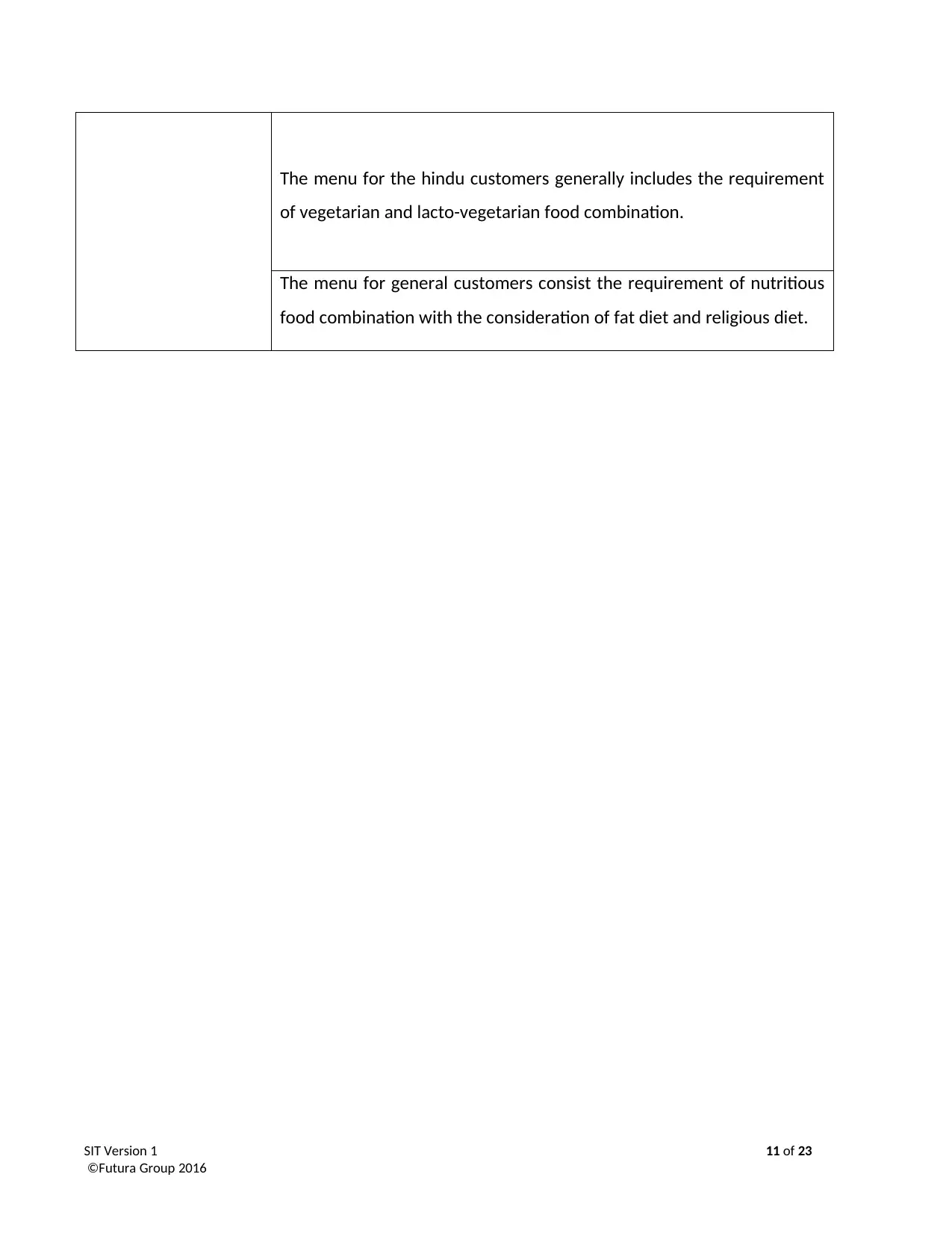
The menu for the hindu customers generally includes the requirement
of vegetarian and lacto-vegetarian food combination.
The menu for general customers consist the requirement of nutritious
food combination with the consideration of fat diet and religious diet.
SIT Version 1 11 of 23
©Futura Group 2016
of vegetarian and lacto-vegetarian food combination.
The menu for general customers consist the requirement of nutritious
food combination with the consideration of fat diet and religious diet.
SIT Version 1 11 of 23
©Futura Group 2016
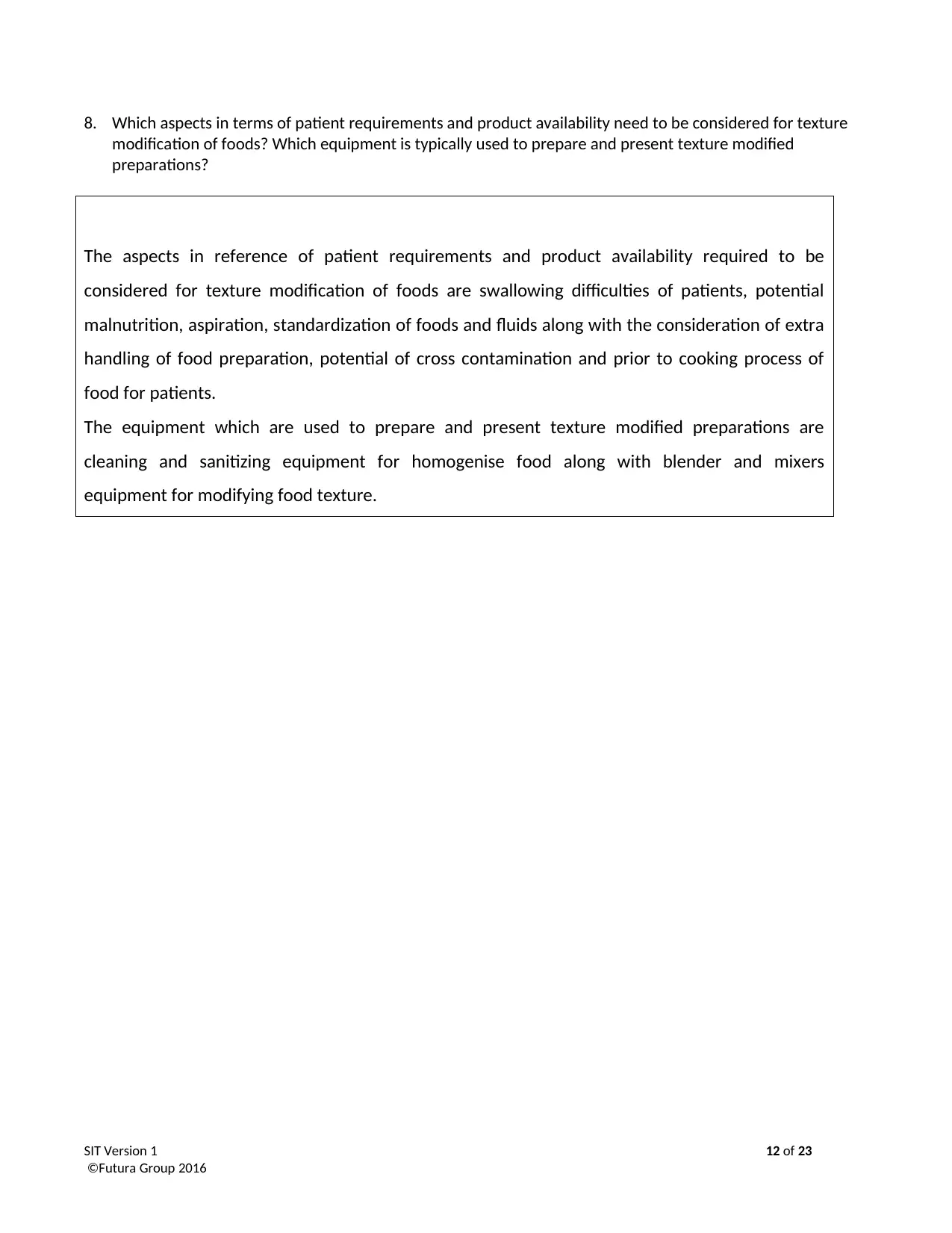
8. Which aspects in terms of patient requirements and product availability need to be considered for texture
modification of foods? Which equipment is typically used to prepare and present texture modified
preparations?
The aspects in reference of patient requirements and product availability required to be
considered for texture modification of foods are swallowing difficulties of patients, potential
malnutrition, aspiration, standardization of foods and fluids along with the consideration of extra
handling of food preparation, potential of cross contamination and prior to cooking process of
food for patients.
The equipment which are used to prepare and present texture modified preparations are
cleaning and sanitizing equipment for homogenise food along with blender and mixers
equipment for modifying food texture.
SIT Version 1 12 of 23
©Futura Group 2016
modification of foods? Which equipment is typically used to prepare and present texture modified
preparations?
The aspects in reference of patient requirements and product availability required to be
considered for texture modification of foods are swallowing difficulties of patients, potential
malnutrition, aspiration, standardization of foods and fluids along with the consideration of extra
handling of food preparation, potential of cross contamination and prior to cooking process of
food for patients.
The equipment which are used to prepare and present texture modified preparations are
cleaning and sanitizing equipment for homogenise food along with blender and mixers
equipment for modifying food texture.
SIT Version 1 12 of 23
©Futura Group 2016
⊘ This is a preview!⊘
Do you want full access?
Subscribe today to unlock all pages.

Trusted by 1+ million students worldwide
1 out of 23
Related Documents
Your All-in-One AI-Powered Toolkit for Academic Success.
+13062052269
info@desklib.com
Available 24*7 on WhatsApp / Email
![[object Object]](/_next/static/media/star-bottom.7253800d.svg)
Unlock your academic potential
Copyright © 2020–2025 A2Z Services. All Rights Reserved. Developed and managed by ZUCOL.



